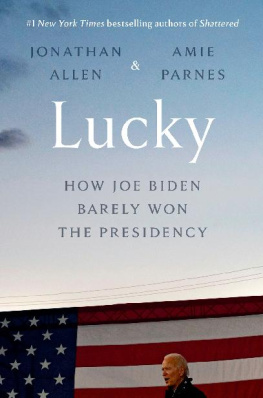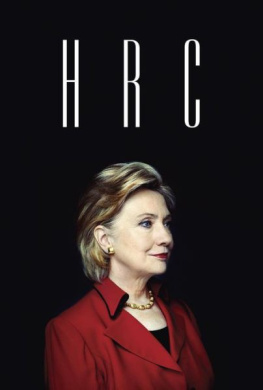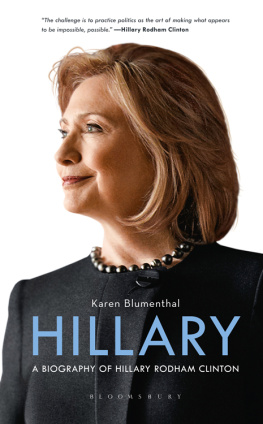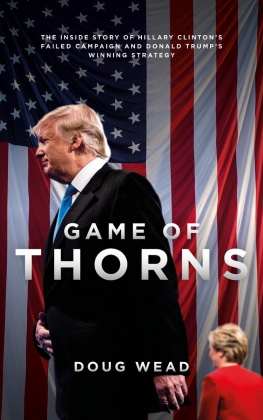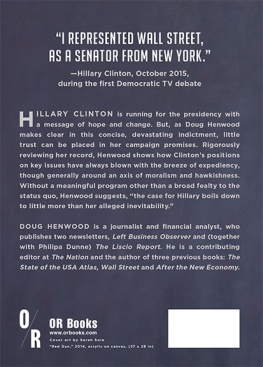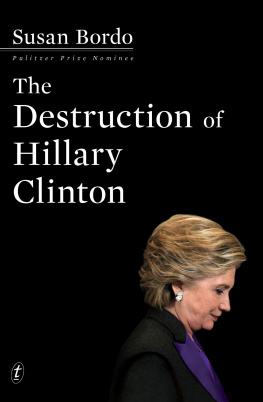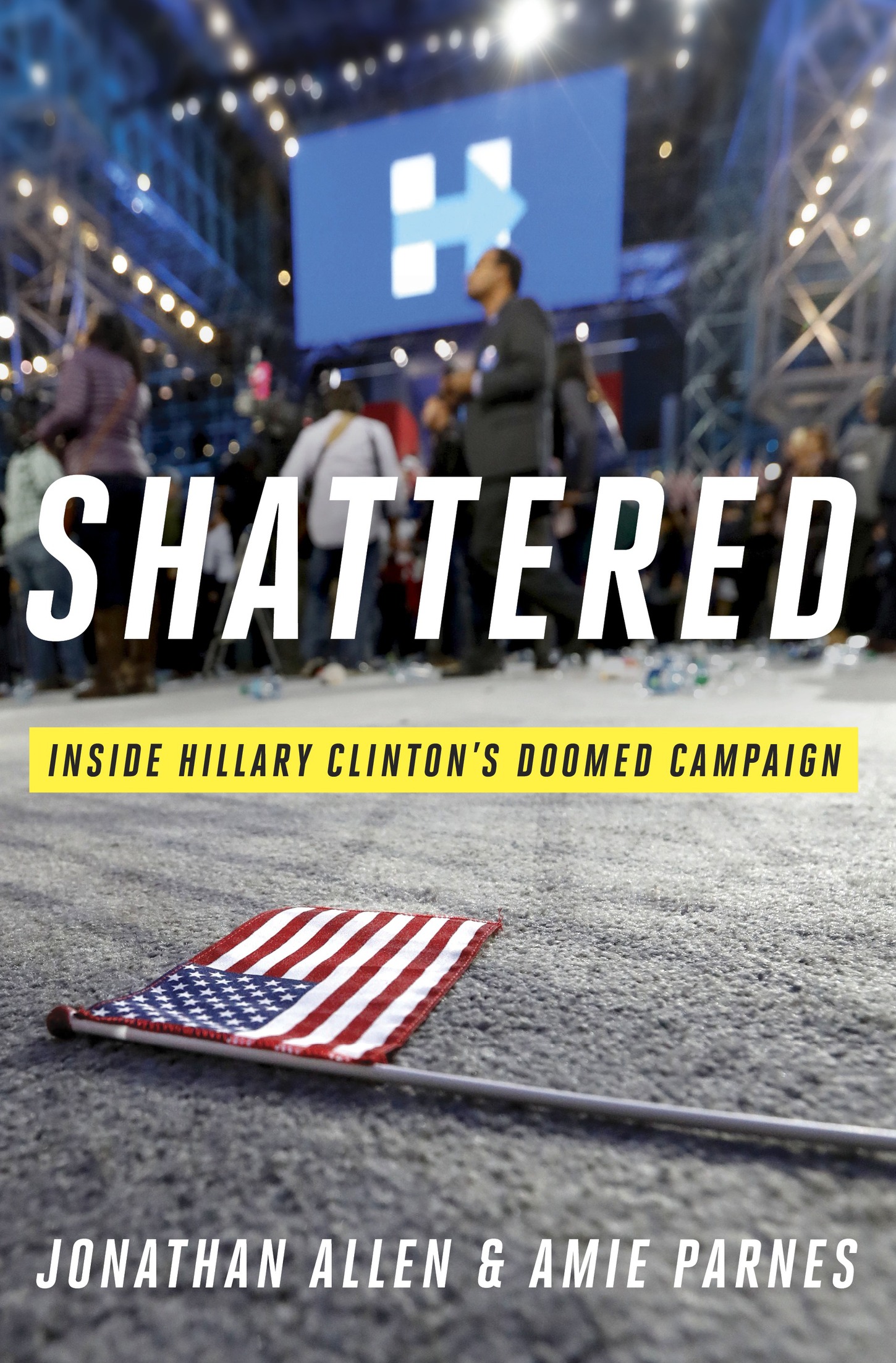All rights reserved.
Published in the United States by Crown, an imprint of the Crown Publishing Group, a division of Penguin Random House LLC, New York.
CROWN and colophon is a registered trademark of Penguin Random House LLC.
Library of Congress Cataloging-in-Publication Data is available upon request.
W hen we first began reporting for this book in late 2014, Hillary Clinton was the candidate to beat for the presidency. Her rsumfirst lady, senator, and secretary of statewas unassailable. At her peak in the last job, two-thirds of Americans had approved of her performance. More important, she had spent a great deal of time and energy trying to correct the flaws of her 2008 Democratic primary loss to Barack Obama. And most political analysts believed that Democrats, coming off his consecutive victories, had two powerful advantages in presidential elections: a mortal lock on states that provided 242 of the 270 electoral votes needed to win the White House and a superior handle on the mechanics of turning out voters.
Hillary and her husband, former president Bill Clinton, had been preparing for this bid for six years. They had rewarded friends and punished disloyal Democrats after the 2008 race. Bill had raised money for Obama and delivered a rousing endorsement of the sitting president at the 2012 Democratic National Convention, a move that helped seal the Obama-Clinton bond. He had campaigned in Democratic primaries against candidates who the Clintons felt had betrayed Hillary in 2008. Once she was out of government, Hillary herself had hit the hustings for Democratic Senate candidates in the 2014 midterm elections. And, in 2013 and 2014, a super PAC run and funded by her allies had raised millions of dollars and collected hundreds of thousands of names of potential supporters. They were Ready for Hillary.
Having written the 2014 book HRC: State Secrets and the Rebirth of Hillary Clinton, we were convinced that she was indeed running and that no other Democrat could defeat her in the primarythe same conclusion that kept most serious Democrats from running against her. Moreover, as party political figures told us, the fear of reprisal meant that there was a cost for Democrats who didnt jump on her bandwagon. Some, like Missouri senator Claire McCaskill, endorsed her long before she committed to a run. In short, Hillary had every imaginable institutional advantage in winning the Democratic nomination. As David Plouffe, the mastermind behind Obamas 2008 victory, put it in a private conversation in September 2014, Shes bulletproof.
Of course, there were reasons to think that she wouldnt just waltz into the White House. Its hard for a party to win three consecutive presidential elections. The rise of the Tea Party and other anti-institutional forces in both parties had wreaked havoc on the establishment since Obamas first election. And Hillary had always been a polarizing figure in American politicsparticularly when she was a candidate.
But, heading into our reporting, we thought there was a pretty good chance that we would be writing the inside story of Hillary shattering what she had called the highest, hardest glass ceiling.
We were surprised, then, when Clintonworld sources started telling us in 2015 that Hillary was still struggling to articulate her motivation for seeking the presidency. And we were taken aback by how much infighting was going on below the surface of her campaign at a time when, unlike 2008, very little of it had spilled into the press. In so many ways, and as some of our sources acknowledged, Hillary was fighting the last war. She did that with varying degrees of success. But the variable she couldnt change was the candidate.
Over the course of a year and a half, in interviews with more than one hundred sources, we started to piece together a picture that was starkly at odds with the narrative the campaign and the media were portraying publicly. Hillarys campaign was so spirit-crushing that her aides eventually shorthanded the feeling of impending doom with a simple mantra: Were not allowed to have nice things.
Every time it looked like she had hit her stride in the race, a new obstacle appeared in her path. And yet, there were few moments between her kickoff rally and the closing of the first polls on Election Day when she wasnt the favorite. So it wasnt until the results came in that all of our reporting finally made sensethat the foreboding signs along the way had been pointing in the right direction even when they were at odds with the available data.
We made one decision early on in our process that proved crucial in allowing us access to key players even at times when most of the media were walled off from Hillary and her senior staff. We agreed to conduct all of our interviews on background, which provided anonymity to our sources. That gave them an extra sense of security on the off chance that we broke a vow that we observed throughout our reporting: none of the material would appear before the election. We spoke to nearly everyone we asked to interview, up and down the ranks of the campaign, and many of them talked to us during pivotal periods of the race.
Without these guarantees, which protected our sources inside and outside the campaign from the possible reprisal of the next president, many of them would not have talked with us at all. Others would have been much less candid. The trade-offs enabled us to get an extraordinary look at the last, tumultuous chapter of the Clinton era.
In that final hurrah, Hillary broke one glass ceilingbecoming the first female nominee of a major political partyand forever put to rest the question of whether a woman could be seen as commander in chief. She collected nearly 65.9 million votesmore than any Republican nominee in American history, just 64,822 fewer than Barack Obama in 2012, and almost 3 million more than Donald Trump. And she did that while facing a set of trials and tribulations unlike any other in American campaign history: a partisan congressional investigation; a primary opponent who attacked her character; a rogue FBI director; the rank misogyny of her Republican rival; a media that scrutinized her every move while failing to get that Republican rival to turn over his tax returns; and even a Kremlin-based campaign to defeat her.
In the end, though, this was a winnable race for Hillary. Her own misstepsfrom setting up a controversial private e-mail server and giving speeches to Goldman Sachs to failing to convince voters that she was with them and turning her eyes away from working-class whitesgave Donald Trump the opportunity he needed to win.


